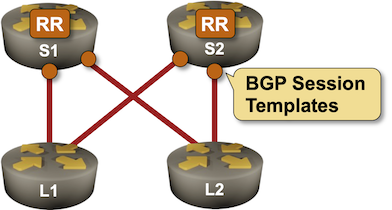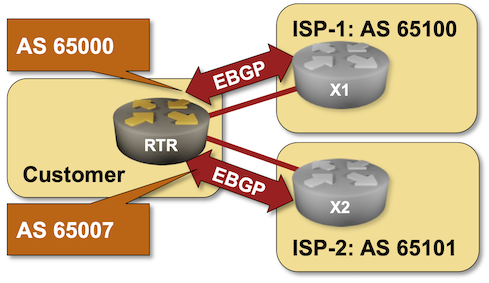Author Archives: Ivan Pepelnjak
Author Archives: Ivan Pepelnjak
Configuring an IBGP session on a route reflector takes a half-dozen parameters, starting with the remote BGP AS number (equal to the local one), remote IP address, and the source IP address or interface. You might have to specify the propagation of BGP communities and an MD5 password, and you will definitely have to specify that the BGP neighbor is a route reflector client.
Wouldn’t it be nice if you could group those parameters into a template and apply the template to a neighbor? Most BGP implementations have something along those lines. That feature could be called a session template or a peer group, and you can practice it in the next BGP lab exercise.

Configuring an IBGP session on a route reflector takes a half-dozen parameters, starting with the remote BGP AS number (equal to the local one), remote IP address, and the source IP address or interface. You might have to specify the propagation of BGP communities and an MD5 password, and you will definitely have to specify that the BGP neighbor is a route reflector client.
Wouldn’t it be nice if you could group those parameters into a template and apply the template to a neighbor? Most BGP implementations have something along those lines. That feature could be called a session template or a peer group, and you can practice it in the next BGP lab exercise.

I mentioned that you don’t need node addresses when dealing with only two entities. Now and then, someone tries to extend this concept and suggests that the network layer addressing isn’t needed if the solution is local. For instance, if we have a solution that is supposed to run only on a single Ethernet segment, we don’t need network layer addressing because we already have data link layer addresses required for Ethernet to work (see also: ATAoE).
Too often in the past, an overly ingenious engineer or programmer got the idea to simplify everyone’s life and use the data link layer addresses as the ultimate addresses of individual nodes. They would then put the transport layer on top of that to get reliable packet transport. Finally, put whatever application on top of the transport layer. Problem solved.
I mentioned that you don’t need node addresses when dealing with only two entities. Now and then, someone tries to extend this concept and suggests that the network layer addressing isn’t needed if the solution is local. For instance, if we have a solution that is supposed to run only on a single Ethernet segment, we don’t need network layer addressing because we already have data link layer addresses required for Ethernet to work (see also: ATAoE).
Too often in the past, an overly ingenious engineer or programmer got the idea to simplify everyone’s life and use the data link layer addresses as the ultimate addresses of individual nodes. They would then put the transport layer on top of that to get reliable packet transport. Finally, put whatever application on top of the transport layer. Problem solved.
One of the few beauties of most “industry standard CLI” implementations1 is that they’re idempotent: nothing changes (apart from ACLs) if you configure the same stuff a dozen times. Most of these implementations allow you to deconfigure the same stuff multiple times; FRRouting is one of the unfortunate exceptions.
Imagine you have a bunch of IP prefixes you want to advertise with BGP. You could use network statements within the router bgp configuration to get that done:
One of the few beauties of most “industry standard CLI” implementations1 is that they’re idempotent: nothing changes (apart from ACLs) if you configure the same stuff a dozen times. Most of these implementations allow you to deconfigure the same stuff multiple times; FRRouting is one of the unfortunate exceptions.
Imagine you have a bunch of IP prefixes you want to advertise with BGP. You could use network statements within the router bgp configuration to get that done:
Can you use BGP to connect to the global Internet without having a public BGP AS number? Of course, assuming your Internet Service Provider is willing to run BGP with a network using a private AS number. But what happens if you want to connect to two ISPs? It’s ridiculous to expect you’ll be able to persuade them to use the same private AS number.

That’s one of the many use cases for the local-as functionality available in most BGP implementations. You can practice it in the Use Multiple AS Numbers on the Same Router lab exercise.
Can you use BGP to connect to the global Internet without having a public BGP AS number? Of course, assuming your Internet Service Provider is willing to run BGP with a network using a private AS number. But what happens if you want to connect to two ISPs? It’s ridiculous to expect you’ll be able to persuade them to use the same private AS number.

That’s one of the many use cases for the local-as functionality available in most BGP implementations. You can practice it in the Use Multiple AS Numbers on the Same Router lab exercise.
I stay as far away from Ansible as possible these days and use it only as a workflow engine to generate device configurations from Jinja2 templates and push them to lab devices. Still, I manage to trigger unexpected behavior even in these simple scenarios.
Ansible has a complex system of variable (fact) precedence, which mostly makes sense considering the dozen places where a variable value might be specified (or overwritten). Ansible documentation also clearly states that the extra variables (specified on the command line with the -e keyword) have the highest precedence.
Now consider these simple playbooks. In the first one, we’ll set a fact (variable) and then print it out:
I stay as far away from Ansible as possible these days and use it only as a workflow engine to generate device configurations from Jinja2 templates and push them to lab devices. Still, I manage to trigger unexpected behavior even in these simple scenarios.
Ansible has a complex system of variable (fact) precedence, which mostly makes sense considering the dozen places where a variable value might be specified (or overwritten). Ansible documentation also clearly states that the extra variables (specified on the command line with the -e keyword) have the highest precedence.
Now consider these simple playbooks. In the first one, we’ll set a fact (variable) and then print it out:
When I described the need to turn off the BGP AS-path loop prevention logic in scenarios where a Service Provider expects a customer to reuse the same AS number across multiple sites, someone quipped, “but that should be fixed by the Service Provider, not offloaded to the customer.”
Not surprisingly, there’s a nerd knob for that (AS override), and you can practice it in the next BGP lab exercise: Fix AS-Path in Environments Reusing BGP AS Numbers.

When I described the need to turn off the BGP AS-path loop prevention logic in scenarios where a Service Provider expects a customer to reuse the same AS number across multiple sites, someone quipped, “but that should be fixed by the Service Provider, not offloaded to the customer.”
Not surprisingly, there’s a nerd knob for that (AS override), and you can practice it in the next BGP lab exercise: Fix AS-Path in Environments Reusing BGP AS Numbers.


All the Container Network Interface videos from the Kubernetes Networking Deep Dive webinar with Stuart Charlton are now public. Enjoy!
One of the ipSpace.net subscribers sent me this question:
How could I use NSX to create a cloud-like software network layer enabling a VMware enterprise to create a public cloud-like availability zone concept within a data center (something like Oracle Cloud does)?
That’s easy: stop believing in VMware marketing shenanigans.
One of the ipSpace.net subscribers sent me this question:
How could I use NSX to create a cloud-like software network layer enabling a VMware enterprise to create a public cloud-like availability zone concept within a data center (something like Oracle Cloud does)?
That’s easy: stop believing in VMware marketing shenanigans.
Figuring out how to describe your network (also known as “create a source of truth”) is one of the most challenging tasks you’ll face when building a network automation solution (more). As always, the devil is in the details, starting with “and what exactly is The Truth?”.
We discussed those details in a lively Packet Pushers podcast with Claudia de Luna, David Sinn, Dinesh Dutt, Drew Conry-Murray and Ethan Banks. Have fun!
Figuring out how to describe your network (also known as “create a source of truth”) is one of the most challenging tasks you’ll face when building a network automation solution (more). As always, the devil is in the details, starting with “and what exactly is The Truth?”.
We discussed those details in a lively Packet Pushers podcast with Claudia de Luna, David Sinn, Dinesh Dutt, Drew Conry-Murray and Ethan Banks. Have fun!
FRR or (pre-NVUE) Cumulus Linux are the best bets if you want to run BGP labs in a resource-constrained environment like your laptop or a small public cloud instance. However, they both behave a bit differently from what one might expect from a networking device, including:
A new lab exercise covers these intricate details and will help you get fluent in configuring BGP on FRR or Cumulus Linux virtual machines or containers.
FRR or (pre-NVUE) Cumulus Linux are the best bets if you want to run BGP labs in a resource-constrained environment like your laptop or a small public cloud instance. However, they both behave a bit differently from what one might expect from a networking device, including:
A new lab exercise covers these intricate details and will help you get fluent in configuring BGP on FRR or Cumulus Linux virtual machines or containers.
A networking engineer with a picture-perfect implementation of a dual-homed enterprise site using BGP communities according to RFC 1998 to select primary- and backup uplinks contacted me because they experienced unacceptably long failover times.
They measured the failover times caused by the primary uplink loss and figured out it takes more than five minutes to reestablish Internet connectivity to their site.